Try our free TASC Science practice test. This online exam includes challenging practice questions along with detailed explanations. The questions and topics are designed to be similar to those on the actual test. The TASC Science Test focuses on life science, earth science, and space science. It includes 47 questions that must be answered within 85 minutes. Start your test prep right now with our free practice test!
Congratulations - you have completed .
You scored %%SCORE%% out of %%TOTAL%%.
Your performance has been rated as %%RATING%%
Your answers are highlighted below.
Question 1 |
What kind of rock is created when existing rock types are transformed by heat and pressure?
metamorphic | |
igneous | |
sedimentary | |
meteorological |
Question 1 Explanation:
The correct answer is (A). When a rock is subjected to extreme heat and pressure, profound physical and chemical changes can occur, resulting in the formation of a new rock. The different rock types can be remembered by learning their respective root words: “metamorph” indicates a change of shape, “ignis” means fire, and “sediments” are small particles usually carried by water. The key word “transformed” indicates that metamorphic rock is formed. Metamorphic rocks make up a large part of the Earth's crust. They include marble, slate, gneiss, quartzite, and schist.
Question 2 |
Elements that are in the same column of the periodic table are in the same:
period | |
group | |
row | |
classification |
Question 2 Explanation:
The correct answer is (B). Elements in the same vertical column are in the same group, and they react to other elements in similar ways. Elements in the same horizontal row are in the same period, and they have similar physical properties. There are 7 periods and 18 groups.
Question 3 |
Use the energy pyramid below to answer the following question.

What would be considered a secondary consumer?
An autotrophic organism that produces energy from sunlight. | |
A worm that finds its nutrients in decaying roots and leaves. | |
A hawk that eats robins and other small omnivores. | |
A robin that eats worms and other insects. |
Question 3 Explanation:
The correct answer is (D). A secondary consumer is an organism that acquires its energy after the energy has been transferred twice (i.e. sunlight ⇒ plant ⇒ worm). The energy pyramid above can be used to solve this problem by fitting each answer into a level on the pyramid. An autotrophic organism, such as a plant, that produces energy from sunlight, is a primary producer. An insect, such as a worm, that finds its nutrients in the decaying roots and leaves of plants is a primary consumer. A robin that eats worms and other insects is a secondary consumer because it eats primary consumers. A hawk that eats robins and other small omnivores is a tertiary consumer because it eats secondary consumers.
Question 4 |
Humans can breed plants and animals to have useful traits. By selecting which animals are allowed to reproduce, humans can influence an organism’s genotype. What name did Darwin use to describe this process?
natural selection | |
artificial selection | |
survival of the fittest | |
hybridism |
Question 4 Explanation:
The correct answer is (B). Darwin used the term artificial selection to distinguish this process from natural selection. Natural selection is the process by which living things with beneficial traits produce the greatest number of offspring. It results in changes in the traits of living things over time, as those organisms most fit for reproduction are more likely than less fit organisms to pass on their genes. Artificial selection, on the other hand, is the reproduction of organisms with beneficial traits resulting from the influence of humans. ‘Survival of the fittest’ describes natural, not artificial, selection, and hybridism describes an organism of mixed origin, which is not necessarily something bred to exhibit useful traits.
Question 5 |
Two objects on Earth are dropped from the top of a building that is 70 meters high. Object A has a mass of 12 g and object B has a mass of 6 kg. Assuming there is no air resistance, which object will hit the ground first?
Object A. | |
Object B. | |
Both objects will hit the ground at the same time. | |
There is not enough information to determine an outcome. |
Question 5 Explanation:
The correct answer is (C). Without air resistance, the only force acting on the two objects is the Earth’s gravitational field. Consequently, the acceleration of both object A and object B is independent of mass, and every second, both velocities will increase by 9.8 meters per second. Given that both objects are dropped from the same height, and they both travel at the same rate, they will both hit the ground at the same time.
Question 6 |
The birds pictured below are able to pick out food from the fur of the deer. The deer will not attack the birds. In fact, the deer knowingly lets the birds rest on it.
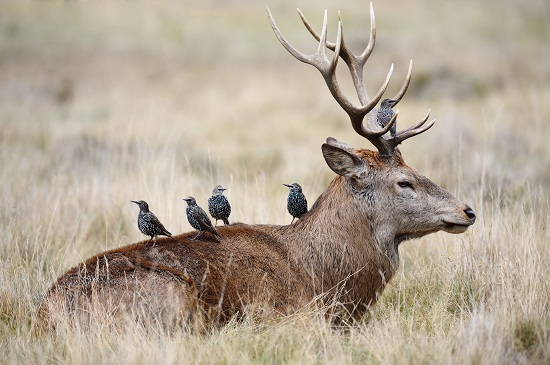
Which term best describes the relationship between the birds and the deer?
symbiosis | |
adaptation | |
competition | |
homeostasis |
Question 6 Explanation:
The correct answer is (A). Symbiosis describes a close relationship between organisms of different species in which at least one of the organisms benefits. The other organism may also benefit, or it may be unaffected or harmed by the relationship. While the relationship can be described as an adaptation (of the birds), symbiosis is a more accurate definition of the interaction. In this case, the two species are not competing over resources, nor is homeostasis (a return to a stable equilibrium between two systems) taking place.
Question 7 |
Which of these subatomic particles have a positive electric charge?
neutrons | |
protons | |
electrons | |
atoms |
Question 7 Explanation:
The correct answer is (B). The basic unit of matter is called the atom. It consists of a dense nucleus made of positively charged protons and neutrally charged neutrons. Negatively charged subatomic particles called electrons exist inside of orbitals surrounding the nucleus. The charge of the proton can easily be remembered because both proton and positive begin with ‘p.’ Neutrons sound like neutral, and electrons are left to have the negative charge.
Question 8 |
Which of the following best restates the law of conservation of energy?
The total energy of a system always diminishes. | |
Energy cannot be created or destroyed, only changed. | |
The sum of all forces equals the amount of energy in a system. | |
Mechanical and potential energy share an inverse relationship. |
Question 8 Explanation:
The correct answer is (B). The law of conservation of energy states that the total energy of an isolated system remains constant. Energy cannot be created or destroyed, but it can change from one form to another. For example, an object dropped from a rooftop will undergo a change from potential energy to kinetic energy and hit the floor with a force equal to the amount of work done on the object by gravity.
Question 9 |
Two mice mate and produce offspring. Both of the mice have the genotype (Gg) which results in the phenotype of grey fur color. Use the Punnett square below to calculate the probability that these two mice will produce an offspring with white fur (gg).
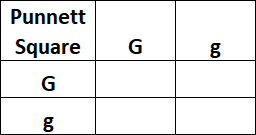
25% | |
50% | |
75% | |
0% |
Question 9 Explanation:
The correct answer is (A). The complete Punnett square below shows that the chance of the individual having the genotype which produces the phenotype of white fur is 1 in 4, or 25%. Half of the offspring, 2 out of 4, will have the genotype of (Gg), which is the heterozygous phenotype of grey fur. Another quarter of the offspring will have the genotype (GG), which is homozygous dominant, meaning it will also have grey fur.
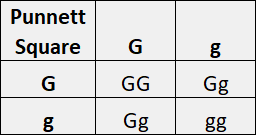

Question 10 |
Which of the following provides the correct hierarchy of organization present in every multicellular organism (from the least complex to the most complex)?
atom, molecule, organelle, cell, tissue, organ, organ system, organism | |
atom, molecule, cell, organelle, organ, organism | |
atom, cell, molecule, organelle, organ system, organ, organism | |
atom, cell, molecule, organ, organelle, organism |
Question 10 Explanation:
The correct answer is (A). The correct hierarchical organization of multicellular organisms begins with the atom, the smallest unit. Molecules are two or more atoms bonded together. Organelles are multiple molecules bonded together that exhibit various functions within a cell. Next is the cell, the most basic unit of life. Multiple cells combine to form tissues, which combine to form organs. Multiple organs work together in organ systems, and organisms are made up of several organ systems.
Question 11 |
What numbers are needed in the blank spaces to balance the chemical equation?
S8 + __F2 → __SF6
5, 8 | |
24, 8 | |
6, 10 | |
8, 24 |
Question 11 Explanation:
The correct answer is (B). Due to the law of conservation of matter, the number of sulfur and fluorine molecules on each side of the reaction must be equivalent. Therefore, the S8 on the reactant side of the equation necessitates 8 SF6 molecules on the product side. Doing so generates a total of 6 * 8 = 48 fluorine molecules on the product side that must be balanced on the reactant side. It is given that fluorine reacts as F2, and we know that 48 total fluorine atoms are necessary. Dividing 48 by 2 gives the correct coefficient for the reacting F2.
Question 12 |

What is the common name of the cycle shown above?
hydrologic cycle | |
carbon cycle | |
nitrogen cycle | |
phosphorous cycle |
Question 12 Explanation:
The correct answer is (A). The most commonly accepted name for the cycle of condensation ⇒ precipitation ⇒ evaporation is the hydrologic cycle, also known as the water cycle. Condensation is the cooling of evaporated water to form clouds. Precipitation is the return of water to the Earth's surface. Evaporation is the rising of vaporized water from the Earth's surface into the atmosphere.
Question 13 |
Which of the following is equal to the atomic number of a chemical element?
number of protons | |
number of neutrons | |
mass number | |
number of atoms |
Question 13 Explanation:
The correct answer is (A). The atomic number of an element is a unique identifier that indicates the number of protons found in the nucleus of an atom of that element. In an uncharged atom, the atomic number is also equal to the number of electrons. This makes sense because protons are positively charged and electrons are negatively charged—having the same number of protons and electrons gives an overall, uncharged atom.
Question 14 |
A cladogram is a diagram that organizes species into groups based on their similarities. It also shows evolutionary relationships among the groups.
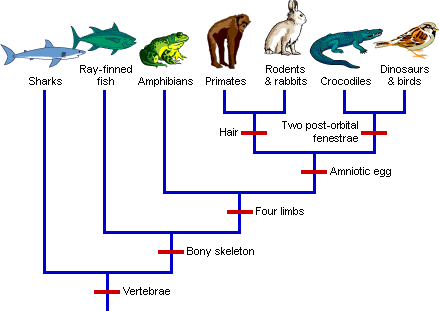
Based on the information in this cladogram, which of these statements is true?
Primates evolved from sharks. | |
The original ancestor of all the species on the cladogram had a bony skeleton. | |
Dinosaurs are more closely related to crocodiles than they are to amphibians. | |
Ray-finned fish have an amniotic egg. |
Question 14 Explanation:
The correct answer is (C). Use the cladogram to evaluate each answer choice.
The cladogram shows that dinosaurs and crocodiles are closely related. They both have an amniotic egg and they both have two post-orbital fenestrae. Amphibians branched off before either of these developments, so they are less closely related.
Primates and sharks are on two different branches of this cladogram, so primates did not evolve from sharks. The cladogram shows that the original ancestor of all of these species was a vertebrate, but the original ancestor of the shark did not have a bony skeleton. Ray-finned fish branched off before the evolution of the amniotic egg.
The cladogram shows that dinosaurs and crocodiles are closely related. They both have an amniotic egg and they both have two post-orbital fenestrae. Amphibians branched off before either of these developments, so they are less closely related.
Primates and sharks are on two different branches of this cladogram, so primates did not evolve from sharks. The cladogram shows that the original ancestor of all of these species was a vertebrate, but the original ancestor of the shark did not have a bony skeleton. Ray-finned fish branched off before the evolution of the amniotic egg.
Question 15 |
Which TWO of these energy sources produce the most carbon dioxide?
nuclear | |
wind | |
solar | |
coal | |
natural gas | |
hydroelectric |
Question 15 Explanation:
The correct answers are (D) and (E). Fossil fuels include coal, natural gas, and oil. Fossil fuels are the primary source of power for most of the world. Burning these fuels produces carbon dioxide, which is a greenhouse gas that contributes to global warming.
Question 16 |
What process is illustrated in the diagram below?
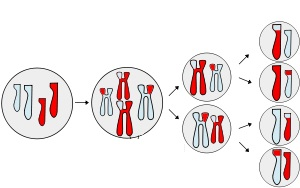
codification | |
mutation | |
mitosis | |
meiosis |
Question 16 Explanation:
The correct answer is (D). The processes of meiosis and mitosis both involve cellular reproduction. The major difference between the two is that mitosis produces daughter cells that are identical to the parent cells whereas meiosis results in cells that are not identical to the parent cells. In the diagram, it can be seen that the cells produced do not match the parent cells. The diagram shows the process of meiosis.
Question 17 |
The tilt of the Earth's rotational axis toward or away from the sun causes:
seasons | |
global warming | |
daylight savings time | |
24-hour days |
Question 17 Explanation:
The correct answer is (A). Because of Earth's axial tilt, different areas of Earth point toward or away from the Sun at different times of the year. In June, the North Pole is tilted toward the Sun and the Northern Hemisphere receives more of the Sun's direct rays. At the same time, the South Pole points away from the Sun, creating winter in the Southern Hemisphere during the months of June, July and August.
Question 18 |
Which of the following is the best example of homeostasis?
A plant that uses light energy to make sugars from carbon dioxide and water. | |
A fish that evolves to live in fresh water. | |
A single cell divides into two identical daughter cells. | |
The human body regulating its internal temperature by shivering or sweating. |
Question 18 Explanation:
The correct answer is (D). Homeostasis is the tendency of the body to seek and maintain a condition of internal equilibrium, even when faced with external changes. One example is the body's ability to maintain an internal temperature of 98.6 degrees Fahrenheit, whatever the temperature outside.
Question 19 |

What process does this equation represent?
nuclear fusion | |
photosynthesis | |
nuclear fission | |
cellular respiration |
Question 19 Explanation:
The correct answer is (B). Photosynthesis is the process through which plants absorb and convert light energy from the sun into chemical energy with oxygen acting as a byproduct. The plants store this energy in the form of glucose (sugar).
Question 20 |
What type of reaction is shown in the equation below?
Reactants ⇒ Products + Energy
endothermic reaction | |
exothermic reaction | |
synthesis reaction | |
double displacement reaction |
Question 20 Explanation:
The correct answer is (B). An exothermic reaction is a chemical reaction that releases energy to its surroundings in the form of light or heat. An endothermic reaction is a chemical reaction that absorbs energy from its surroundings. A synthesis reaction is a process by which two simple compounds join to become a more complex compound, it can be generalized as A + B → AB. A double displacement reaction occurs when two compounds ‘trade’ ions, it can be generalized as AB + XY → AY + XB.
Question 21 |
Select TWO processes that will cycle carbon and oxygen through an ecosystem.
respiration | |
transpiration | |
condensation | |
evaporation | |
nitrification | |
photsynthesis |
Question 21 Explanation:
The correct answers are (A) and (F). Respiration is the process by which living organisms produce energy, typically with the intake of oxygen and the release of carbon dioxide. Photosynthesis is the process used by plants to convert light energy into chemical energy. During photosynthesis plants convert carbon dioxide into oxygen.
Respiration and photosynthesis are important components of the carbon cycle. The carbon cycle is a combination of processes, including photosynthesis, decomposition, and respiration, by which carbon cycles throughout the land, oceans, and atmosphere.
Respiration and photosynthesis are important components of the carbon cycle. The carbon cycle is a combination of processes, including photosynthesis, decomposition, and respiration, by which carbon cycles throughout the land, oceans, and atmosphere.
Question 22 |
What is true of mitosis?
It is sexual reproduction. | |
It produces four haploid daughter cells. | |
It involves only one cell division | |
The number of chromosomes is reduced by half. |
Question 22 Explanation:
The correct answer is (C). Mitosis is the process of asexual reproduction in which a cell divides in two, producing a replica with an equal number of chromosomes. It involves one cell division that results in 2 diploid daughter cells that are genetically equivalent.
Question 23 |
The Big Bang theory is a model used to explain the:
reason the universe was created. | |
beginning of life. | |
origin of the universe. | |
law of gravity. |
Question 23 Explanation:
The correct answer is (C). The Big Bang theory is the most popular and widely accepted explanation for how the universe began. According to the Big Bang model, all of the current and past matter in the universe came into existence at the same time (about 13.8 billion years ago). At this time, all matter was compacted into a very small ball with infinite density called a singularity. Suddenly, the singularity expanded, and the universe as we know it began.
Question 24 |
Which of the following best explains the movement of tectonic plates?
the Coriolis effect | |
ocean currents | |
rotation of the Earth | |
convection in the Earth's mantle |
Question 24 Explanation:
The correct answer is (D). The rigid, outermost shell of Earth is called the lithosphere, and it is broken up into 7 or 8 large tectonic plates as well as many smaller plates. These plates are responsible for continental drift, the slow creeping movement of the continents. The leading theory states that this motion originates in the Earth's mantle and is caused by convection currents carrying heat from the interior of the planet to the surface.
Question 25 |
How does the sun produce energy?
Nuclear fusion of hydrogen atoms into helium atoms. | |
Combustion of hydrocarbons. | |
Nuclear fission of uranium-235. | |
A chemical reaction between gases and oxygen. |
Question 25 Explanation:
The correct answer is (A). Nuclear fusion occurs as a result of the extreme temperature and pressure inside of the sun. Hydrogen atoms fuse together to form deuterium atoms which then fuse to form helium 3 and helium 4; the nuclear fusion of two hydrogen atoms gives off energy as it is an exothermic process.
Question 26 |
Use the table below to determine if the following hypothesis is supported by the given data.
Hypothesis: If more energy is derived from renewable resources (wind, solar, and water) annually, there will be less energy derived from coal; therefore CO2 emissions will decrease annually.
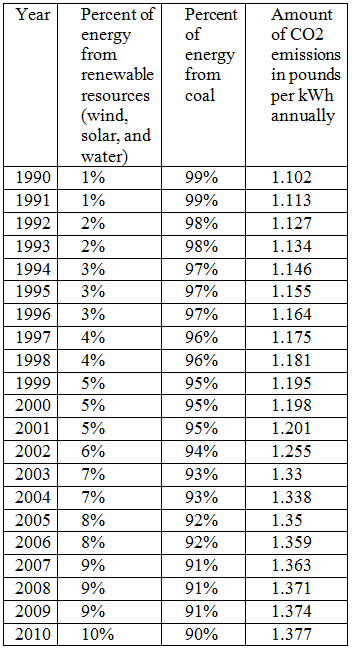
The hypothesis is supported because: more energy is derived from renewable resources annually and less CO2 emissions accrue annually. | |
The hypothesis is supported because: more energy is derived from renewable resources annually and more CO2 emissions accrue annually. | |
The hypothesis is not supported because: less energy is derived from renewable resources annually and less CO2 emissions accrue annually. | |
The hypothesis is not supported because: more energy is derived from renewable resources annually and more CO2 emissions accrue annually. |
Question 26 Explanation:
The correct answer is (D). Compare the trend in column 2, energy from renewable resources, with the trend in column 4, CO2 emissions. The hypothesis claims that as the percentage in column 2 increases, the value in column 4 decreases; it can be seen that the data do not support this hypothesis. While more energy is derived from renewable resources, a larger amount of CO2 emissions are accrued. Only answer choice (D) is accurate.
Question 27 |
The table below suggests that decreasing the percentage of coal used for energy annually correlates with an increase in CO2 emissions. Given that the processing of coal is the primary contributor to CO2 emissions in the US, which of the following statements may explain the trend shown in the data table?

Although the percentage of total energy derived from coal decreased annually from 1990–2010, the demand for energy and the population in the US increased at a rate greater than can be equilibrated with the decrease in percent of coal energy. Therefore, CO2 emissions have steadily increased. | |
Although the percentage of total energy derived from coal decreased annually from 1990–2010, the demand for energy and the population in the US decreased at a rate greater than can be equilibrated with the increase in percent of coal energy. Therefore, CO2 emissions have steadily increased. | |
The processing of coal must not be the primary contributor to coal emissions in the US. | |
Renewable energy resources such as wind, solar, and water must emit more CO2 than the processing of coal. |
Question 27 Explanation:
The correct answer is (A). Given that energy derived from coal is primarily responsible for the CO2 emissions, and that the amount of emissions increased as the percentage of coal energy decreased, the most likely explanation is that the overall energy demands also increased, resulting in a reduced percentage of coal energy, but an increased overall amount of coal energy required due to the increased population and larger energy demand.
Question 28 |
Tides are changes in the sea levels of the ocean that occur periodically. Which of the following is the cause of ocean tides?
the gravitational pull of the Moon on planet Earth | |
varying wind intensity | |
density differences in sea water | |
movement of tectonic plates |
Question 28 Explanation:
The correct answer is (A). The gravitational pull of the Moon on the Earth is what causes periodic changes in sea levels, also known as tides. Varying wind intensity can cause waves in ocean waters, but is not strong enough to influence the tides. Density differences in seawater can cause ocean currents. Movement of tectonic plates in the ocean can cause large-scale ocean related disasters such as tsunamis. Neither density differences nor tectonic plate movement are strong or consistent enough to influence tides.
Question 29 |
DNA can best be compared to:
People who work within a building. | |
The individual rooms within a building. | |
The architectural blueprints of a building. | |
The steel and bricks that are used to construct a building. |
Question 29 Explanation:
The correct answer is (C). DNA is an abbreviation for deoxyribonucleic acid. It is a molecule that carries the genetic instructions necessary for all organisms to develop, function, and reproduce. Since it holds instructions for making an organism it can best be compared to an architectural blueprint.
Question 30 |
A study was carried out involving the heart rates of 2 subjects, one with previous cycling training and one who self-reported living a sedentary lifestyle. The subjects’ heart rates were measured during 15 minutes of cycling. The graph below depicts the heart rate of each individual as the work rate increased.
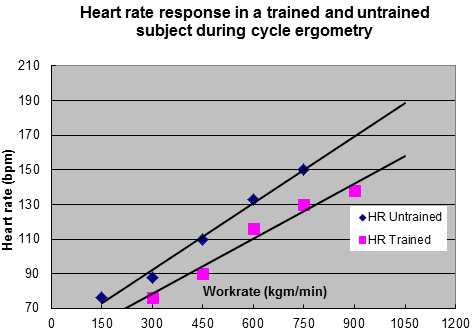

Which of the following conclusions can be inferred from the data depicted in the graph?
The heart rate of the untrained individual was greater than the heart rate of the trained individual throughout the experiment. | |
The heart rate of the trained individual was greater than the heart rate of the untrained individual throughout the experiment. | |
The heart rate of the trained individual increased at a faster rate than that of the untrained individual as the work rate increased. | |
A greater resting heart rate is an indication of an untrained individual. |
Question 30 Explanation:
The correct answer is (A). Notice that at every value along the x-axis, the heart rate of the untrained participant is higher than the heart rate of the trained participant. From this, only answer choice (A) can be inferred.
Question 31 |
The healthy human body sweats when it becomes over heated in order to maintain homeostasis. Which of the following describes the feedback method used by a healthy human to regulate body temperature first in warm surroundings and then in cold surroundings?
When body temperature is too cold, the body starts sweating in order to cool down; when body temperature is too hot, the body starts shivering in order to warm up. | |
When body temperature is too high, the body starts shivering in order to warm up; when body temperature becomes too low, the body starts sweating in order to cool down. | |
When body temperature is too cold, the body starts shivering in order to warm up; when body temperature is too hot, the body starts sweating in order to cool down. | |
When body temperature is too high, the body starts to sweat in order to cool; when the body temperature becomes too low, the body starts shivering in order to warm up. |
Question 31 Explanation:
The correct answer is (D). The body first has to process that there is a need to change and then must properly signal the correct change given the situation. A healthy human body would not begin shivering as a response to overheating, nor sweating as a response to cold. Sweating serves as a cooling mechanism by eliminating heat through evaporation. Shivering generates thermal energy through the small, rapid mechanical motions.
Question 32 |
Animals that feed exclusively on plants are called:
primary consumers | |
secondary consumers | |
tertiary consumers | |
primary producers |
Question 32 Explanation:
The correct answer is (A). In an ecological food chain, primary producers are those that photosynthesize and utilize sunlight as their energy source; this trophic level is almost entirely made up of plants. Primary consumers attain their energy from primary producers; cows are primary consumers as they survive solely on grass. Secondary consumers, such as wolves and eagles, feed upon primary consumers, and tertiary consumers, like great white sharks, feed upon primary and secondary consumers.
Question 33 |
Students are researching families with one brown haired parent and one red haired parent to understand how recessive hair color alleles interact with dominant alleles. They studied the offspring of a heterozygous brown haired man (Bb) and a homozygous recessive red haired woman (bb). Of their four children, three have brown hair and one has red hair. The students prepared the Punnett square that is shown below.


If the couple has another child, what is the probability that this child will have brown hair?
0% | |
25% | |
50% | |
100% |
Question 33 Explanation:
The correct answer is (C). Heterozygous indicates two different alleles for a particular hereditary characteristic. In this case, the man is heterozygous because he has one allele for brown hair (B) and one allele for red hair (b). The brown hair allele is dominant, so it is capitalized, and because it is dominant he has brown hair.
Homozygous indicates two identical alleles for a hereditary characteristic. In this case, the woman has two alleles for red hair (bb). The genes are in lower case since they are recessive. She only has alleles for red hair, so she has red hair.
You can solve this type of problem by filling out a Punnett Square as shown below:

Children with the genotype BB will have brown hair, but none of the children have this combination of alleles.
Children with the genotype Bb will also have brown hair (because B is dominant), and 2 out of every 4 children, or 50%, will have brown hair.
Children with the genotype bb will have red hair, and 2 out of every 4 children will have red hair.
Homozygous indicates two identical alleles for a hereditary characteristic. In this case, the woman has two alleles for red hair (bb). The genes are in lower case since they are recessive. She only has alleles for red hair, so she has red hair.
You can solve this type of problem by filling out a Punnett Square as shown below:

Children with the genotype BB will have brown hair, but none of the children have this combination of alleles.
Children with the genotype Bb will also have brown hair (because B is dominant), and 2 out of every 4 children, or 50%, will have brown hair.
Children with the genotype bb will have red hair, and 2 out of every 4 children will have red hair.
Question 34 |
The graph below shows the population of fur seals on one of the Pribilof Islands, a group of volcanic islands near the coast of Alaska. Scientists believe that fur seals first arrived on this island in the year 1902. The red circles are population estimates and the red line is the population trend line.


Which of the following best describes the carrying capacity of the fur seals?
1,500 | |
6,000 | |
10,500 | |
11,500 |
Question 34 Explanation:
The correct answer is (C). The carrying capacity of a species in a particular environment is the largest population size that the environment can sustain. In this chart the population trend line begins to plateau around 10,500, which indicates that this would be the carrying capacity of the island. Sometimes a population will overshoot the carrying capacity of its ecosystem, but this will cause a shortage of resources, which in turn leads to an increase in the death rate, bringing the population back to equilibrium.
Question 35 |
Which of Newton's laws states the following:
- An object at rest will stay at rest unless an external force acts upon it.
- An object in motion maintains its velocity unless an external force acts upon it.
First Law of Motion | |
Second Law of Motion | |
Third Law of Motion | |
Law of Universal Gravitation |
Question 35 Explanation:
The correct answer is (A). Newton's First Law is often called the law of inertia.
Newton's Second Law states that the acceleration of an object is proportional to the force applied to that object when mass is constant. Stated algebraically: Force = Mass × Acceleration.
Newton's Third Law states that objects exert forces equal in magnitude but opposite in direction on each other. Stated otherwise: For every action, there is an equal and opposite reaction.
Newton's Second Law states that the acceleration of an object is proportional to the force applied to that object when mass is constant. Stated algebraically: Force = Mass × Acceleration.
Newton's Third Law states that objects exert forces equal in magnitude but opposite in direction on each other. Stated otherwise: For every action, there is an equal and opposite reaction.
Question 36 |
An area beneath the ocean floor where tectonic plates move away from each other is known as a:
subduction zone | |
transform fault boundary | |
convergent plate boundary | |
divergent plate boundary |
Question 36 Explanation:
The correct answer is (D). Beneath the ocean floor, tectonic plates move away from each other at the divergent plate boundary. The tectonic plates move away from each other due to the force of magma rising through and splitting the lithosphere, of which the tectonic plates are made.
At a convergent plate boundary the tectonic plates move toward one another and collide. A subduction zone is where plates collide and one plate is forced under the other. At a transform fault boundary two plates slide past each other.
At a convergent plate boundary the tectonic plates move toward one another and collide. A subduction zone is where plates collide and one plate is forced under the other. At a transform fault boundary two plates slide past each other.
Question 37 |
The addition of a catalyst to a chemical reaction will have what effect?
Increase the energy required for the reaction to take place. | |
Increase the time required for the reaction to take place. | |
Increase the rate at which the reaction takes place. | |
Reduce the amount of products in the reaction. |
Question 37 Explanation:
The correct answer is (C). A catalyst, by definition, is a compound that increases the rate at which a reaction takes place by offering an alternative reaction pathway with a reduced activation energy. Catalysts are not consumed in a reaction.
Question 38 |
What name is given to a diagram that represents a single pathway by which energy and matter flow through an ecosystem?
trophic level | |
food chain | |
food web | |
energy pyramid |
Question 38 Explanation:
The correct answer is (B). A food chain is a diagram that shows a single pathway through which energy in the form of food flows from primary producers to primary, secondary, and tertiary consumers. A food web is a system of interlocking and interdependent food chains.
Question 39 |
The energy of an object resulting solely from motion is:
kinetic energy | |
thermal energy | |
mechanical energy | |
potential energy |
Question 39 Explanation:
The correct answer is (A). Kinetic energy is the energy which an object possesses because of its motion. Potential energy is the stored energy in an object due to its position or its configuration. Thermal energy relates an object’s energy to its temperature. The mechanical energy of an object is the sum of its kinetic and potential energy.
Once you are finished, click the button below. Any items you have not completed will be marked incorrect.
There are 39 questions to complete.
|
List |
